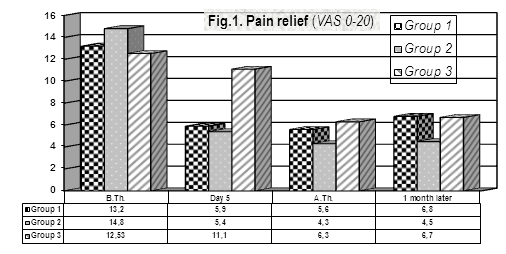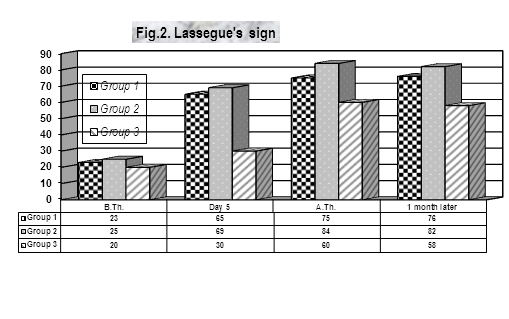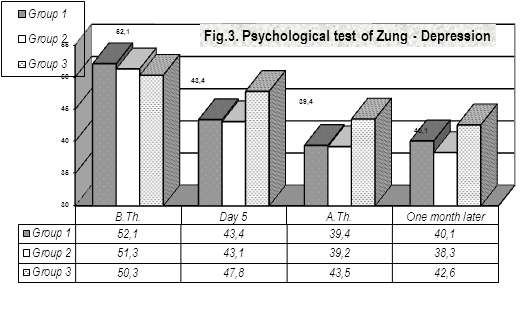1.INTRODUCTION:
A lot of patients suffer from chronic pain. All modern scheduled drugs used for treatment of the persistent pain (opioids, NSAIDs, COX-2 inhibitors) are associated with limitations and side effects [10, 11]. Our purpose was to remind the wide public of the impact of physical modalities in pain management in adults.
Deep Oscillation® Therapy was originated in Germany in 1988 [19]. Deep Oscillation (DO) is a modern physical factor, based on the influence of the electrostatic field on tissues in profundity, explained with the effect, named after Danish engineers F. A. Johnsen and K. Rahbek [20]. The Johnsen–Rahbek effect occurs when an electric potential is applied across the boundary between a metallic surface and the surface of a semiconducting material. Under these conditions an attractive force appears, whose magnitude depends on the voltage and the specific materials involved. R.Atkinson [1969] described a model expressing the attractive force between the contacting materials as a function of the voltage applied across them [2]. The model, which takes into account the presence of surface irregularities, is obtained by an assessment of the effect of field emission on the electrostatic capacitor forces between the contacting surfaces. This model is the base of modern devices: HIVAMAT & Deep Oscillation ®.
The name HIVAMAT is short for a rather wordy description: (HI) Histological (VA) Variable (MA) Manual (T) Technique [18]. Technically speaking, the HIVAMAT 200™ produces its unique method of micro-massage therapy based on the action of a pulsating, low-frequency, two-phase alternating electrostatic field generated between the practitioner’s hands and patient’s skin [19]. At the level of the connective tissue this intermittent electrostatic field produces an intense resonant vibration and the repetition of this phenomenon in rapid succession generates rhythmic deformations of the tissue (skin, connective, and muscular). The resulting effect includes improvement in microcirculation, better tissue nourishment, enhancement of cellular metabolism, promotion of faster healing even on open wounds, anti-oedema, lymph drainage, anti-fibrosis and detoxifying properties, alleviation of pain and swelling, stimulation of collagen production and tissue regeneration. Deep Oscillation® Therapy has been proven as an effective therapy for: occupational injury and everyday conditions associated with pain, inflammation, swelling and scar tissue; sports injuries; general and surgery aftercare; laser re-surfacing rehabilitation; pre-chiropractic adjustment [1, 9, 12, 14].
2.OBJECTIVE
The GOAL of current study was to realize a comparative evaluation between the efficacy of pure drug therapy, physical analgesia (including Deep Oscillation) and combined anti-pain therapy (drug and physical analgesia) in patients with paravertebral and peripheral radicular pain after spinal surgery for discal hernia.
3.DESIGN OF THE STUDY
3.1.Material and methods:
During the period from June 2012 – to July 2014 a total of 69 patients with persistent back pain and vertebrogenic radiculopathy after spinal surgery for discal hernia were observed and investigated – in-patients of the Clinics of NeuroSurgery and Physical and Rehabilitation Medicine at the University Hospital ‘’St Ivan Rilsky’’ — Sofia. Patients were randomized to three treatment groups of 23 each one.
The distribution women : men was 43 : 26, mean age 49 years +/- 1,6 y. All patients suffer from back pain — with lumbar localization. In all patients we observed vertebral syndrome and radicular syndrome (L5 in 13 patients, S1 – in 19 patients, L5 & S1 – in 37 patients). The vertebral syndrome was total in 48 patients (paravertebral muscle spasm, diminished range of motion of the spine, reduction of the cervical / lumbar lordosis, changes in the thoracic kyphosis, functional scoliosis). All patients had radicular syndrome – in 13 of them only with positive sensory symptoms (numbness, paresthesias, dysesthesias, pain), in 11 patients – with positive and negative sensory symptoms (+ radicular hypesthesia), 45 patients had too negative reflectory symptoms (hypo or areflexia). A detailed kinesiological and pathokinesiological analysis was performed for every patient with functional status, manual muscle test, goniometry, centimetry [4, 5]. Finally, an ICF testing was applied — according the WHO requirements of the International Classification of Functioning, Disabilities and Health, 2001 [17].
The clinical diagnosis of our patients was osteochondrosis, spondylosis and / or spondyloarthrosis, with discal hernia at one or two levels (L4-L5 or/and L5-S1), proved by neuro-imagery (X-ray, CT and/or MRI). Neuro-functional exams (excitomotory electrodiagnostics, electroneurography or electromyography) proved L5 and / or S1 radicular lesions in all patients. The period after the spinal surgery was from 2 weeks to 6 months.
All patients of the three groups were investigated according this Protocol before (B.Th.), during (Day 5) and after (A.Th.) therapy (complex PRM programme of 20 days), and one month after the end of the rehabilitation (1 month later).
3.2.Ethic aspects
The investigation was conducted with consideration for the protection of patients, as outlined in the Declaration of Helsinki, and was approved by the appropriate institutional review board and ethic commission. All patients gave written informed consent before undergoing any examination or study procedure.
3.3.Physical and Rehabilitation Medicine (PRM) programme
Groups 1 received only drug therapy: paravertebral infiltrations with cortico-steroids (Hydrocortisone), B vitamins (B1, B6, B12) and local anesthetic (Lidocain).
Patients of group 3 received only physical modalities: complex rehabilitation programme including deep oscillation (DO — fibromyalgia programme) and kinesitherapy — active analytic exercises (including isometric exercises) and soft tissue techniques (post-isometric relaxation, stretching of the lumbar fascia, manual massage) [13].
In group 2 we applied parallel drug and physical analgesia techniques.
3.4.Statistical analysis was performed with SPSS electronic package, version 11.5. We applied options for two samples comparison) with parametrical analysis of variances ANOVA and non-parametrical distribution and correlation analysis:
- t-test (t—criterium, p value),
- Signed test,
- Signed rank test,
- Kolmogorov – Smirnov test,
- Mann – Whitney (Wilcoxon) W test (W медиана).
The treatment difference was considered to be statistically significant if the p value was < 0.05. In some cases we received lower results of the p-value (p<0.01).
4.RESULTS AND ANALYSIS
The comparative analysis of results shows a significant improvement of the symptoms of the patients, concerning:
- pain relief (visualized by the analysis of results of Visual analogue scale VAS 0-20, 1),

Fig.1. Pain relief (VAS 0-20)
- radiculopathy (Lassegue’s sign – fig.2),

Fig.2. Lassegue’s sign
- depression (express scale of Zung – fig.3).

Fig.3. Psychological tests: ZUNG – Dépression
The drug analgesia in group 1 is fast, but short.
The efficacy in group 3 is slow, but stable, and durable.
We observed best results in group 2.
5.DISCUSSION
The drug therapy is efficient but with short duration. The physical analgesia with Deep Oscillation initiates its effect slowly, but the results are stable. Best efficacy was observed in case of combination of medication with physical modalities – in the beginning due to drugs towards the ‘input’ of physical analgesia.
We consider that the application of Deep Oscillation can alleviate the pain trough different mechanisms: by influence on the cause for irritation of pain receptors, by blocking of nociception, by peripheral sympaticolysis, by activation of reflectory connections.
The construction of a complex physical and rehabilitation programme is needed, because the mechanism of action of different procedures is diverse [11]. This opinion is synchronized with modern tendencies in drug treatment of radiculopathy and neuropathy (during last ten years), in contemporaneous studies a combination of symptomatic and pathogenetically oriented therapy is prescribed.
The influence of physical modalities on the interstitium or milieu interieur of Claude Bernard [3] is the theoretical base for combination of drugs and physical modalities.
The synergy between different physical modalities is the logical base for prescription of complex physical program.
6.CONCLUSION
We could recommend our complex programme for treatment of the paravertebral and radicular neuropathic pain.
ACKNOWLEDGMENTS
Authors thank the Council of Medical Science of the Medical University of Sofia for the support via scientific project № 34 / 2014, Contract № 50 / 2014.
REFERENCES
- Aliyev R., Mikus E.W.J., Reinhold G., Hochsignifikante Therapieerfolge mit DEEP OSCILLATION® in der orthopеdischen Rehabilitation. Orthopadische Praxis 44, 9, 2008, 448-453.
- Atkinson R., A simple theory of the Johnsen-Rahbek effect. Journal of Physics D: Applied Physics, 2, 1969, 3, 325.
- Bernard CІ., Introduction à l’étude de la médicine expérimentale. – Paris: Hachette, 1943.
- Boubee M., Bilans analytiques et fonctionnels en rééducation neurologique. Tome 1. Tronc et membres inférieurs. – Paris: Masson: 1975.
- Boubee M., Bilans analytiques et fonctionnels en rééducation neurologique. Tome 2 – Membres superieurs et bilans specifiques. – Paris: Masson, 1975, pp.12-25 & 89-97.
- Boureau F., Willer J.C., La Douleur – exploration, traitement par neurostimulation et électro-acupuncture. – Paris – New York – Barcelone – Milan: Masson, 1979.
- Calcutt N.A., Dunn J.S., Pain: Nociceptive and Neuropathic Mechanisms. Anesthesiology Clinics of North America, 1997.
- Cox J.M., Low Back Pain — Mechanism, Diagnosis and Treatment. 5-th -Baltimore: Williams & Wilkins, 1990, 437-467.
- Gasbarro V., Bartoletti R., Tsolaki E. et al., Ruolo dell`oscilazione profonda (HIVAMAT® 200) nel trattamento fisico del linfedema degli arti. La medicina estetica, 30, 2006, 473-478.
- Коleva I., Repetitorium physiotherapeuticum (basic principles of the modern physical and rehabilitation medicine). Book for English speaking students of Pleven Medical University. – Sofia: Publishing house “SIMEL”, 2006, 95 p.
- Коleva I., Chronic pain and physical analgesia: the impact of physical modalities to reduce pain. — Journal of Biomedical and Clinical Research, 1, 2008, 1, 12-17.
- Krämer K., Maichl F. Scores, Bewertungsschemata und Klassifikationen in Orthopadie und Stuttgart — New York: Georg Thieme Verlag, 1993, p.418–444.
- La Frenière G., Le patient lombalgique (techniques de traitements kinesitherapiques). – Paris – New York – Barcelone – Milan – Mexico – Sao Paulo: Masson, 1983, 194 p.
- Luther C., Germann G., Holle et al., Das komplexe regionale Schmerzsyndrom (CRPS). CHAZ 6, 2005, 59–67.
- Melzack R., Wall P.D., Pain mechanisms: A new theory. Science, 1965, 150, 971-979.
- Merskey H., Bogduk N. Eds., Classification of chronic pain – descriptions of chronic pain syndromes and definition of pain terms. – Seattle: IASP press, 1994.
- World Health Organization. International Classification of Functioning, Disability and Health (ICF). – Geneva: WHO, 2001.
- https://lewisvillemassage.com/hivamat/
- https://en.wikipedia.org/wiki/Johnsen%E2%80%93Rahbek_effect
- https://iasp-pain.org.[schema type=»book» name=»IMPACT OF DEEP OSCILLATION IN THE COMPLEX REHABILITATION ALGORITHM FOR PATIENTS AFTER SPINAL NEUROSURGERY» description=»A lot of patients suffer from chronic pain. All modern scheduled drugs used for treatment of the persistent pain (opioids, NSAIDs, COX-2 inhibitors) are associated with limitations and side effects. Our purpose was to remind the wide public of the impact of physical modalities in pain management in adults. Deep Oscillation is a modern physical factor, based on the influence of the electrostatic field on tissues in profundity, explained with the Rahbek – Johnson effect. Our purpose was to remind the wide public of the impact of physical modalities in pain management in adults. GOAL: Comparative evaluation of drug, physical (including Deep Oscillation) and combined analgesia in patients with paravertebral and peripheral radicular pain after spinal surgery for discal hernia. MATERIAL AND METHODS: During the period from June 2012 – to July 2014 a total of 69 patients with persistent back pain and vertebrogenic radiculopathy after spinal surgery for discal hernia were observed and investigated – in-patients of the Clinics of NeuroSurgery and Physical and Rehabilitation Medicine at the University Hospital ‘’St Ivan Rilsky’’ – Sofia, Bulgaria. Patients were randomized to three treatment groups of 23 each one. Groups 1 received only drug therapy – paravertebral infiltrations. Patients of group 3 received only physical modalities [complex rehabilitation programme including deep oscillation (DO)]. In group 2 we applied drug and physical analgesia techniques. The investigation was conducted with consideration for the protection of patients, as outlined in the Declaration of Helsinki, and was approved by the appropriate institutional review board and ethic commission. All patients gave written informed consent before undergoing any examination or study procedure. For statistical evaluation we used t-test (ANOVA) and Wilcoxon rank test (non parametrical correlation analysis), performed using SPSS package. The treatment difference was considered to be statistically significant if the p value was < 0.05. The comparative ANALYSIS of RESULTS shows a significant improvement of the symptoms of the patients, concerning: pain relief (visualized by the analysis of results of Visual analogue scale), radiculopathy (Lassegue’s sign), depression (scale of Zung). The drug analgesia in group 1 is fast, but short. The efficacy in group 3 is slow, but stable, and durable. We observed best results in group 2. DISCUSSION: The drug therapy is efficient but with short duration. The physical analgesia with Deep Oscillation initiates its effect slowly, but the results are stable. Best efficacy was observed in case of combination of medication with physical modalities – in the beginning due to the anti-inflammatory drug, toward the moment of effective «input» of physical modalities. Current paper proposes personal opinions on some contemporaneous theories of pain and therapeutic concepts of analgesia, including physical analgesia. Authors apply a conception of pathogenetic mechanisms of physical analgesia in case of application of Deep oscillation. CONCLUSION: We could recommend the complex program for treatment of the paravertebral and radicular pain after spinal surgery.» author=»Koleva Ivet B., Marinov Marin B.» publisher=»БАСАРАНОВИЧ ЕКАТЕРИНА» pubdate=»2017-01-09″ edition=»euroasia-science.ru_29-30.12.2015_12(21)» ebook=»yes» ]

